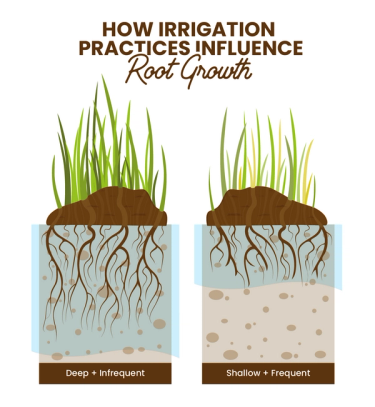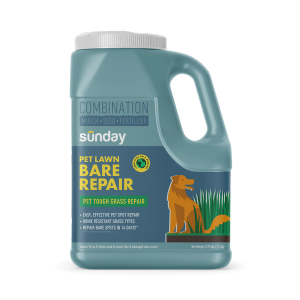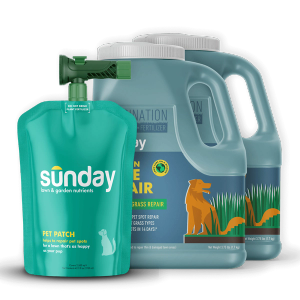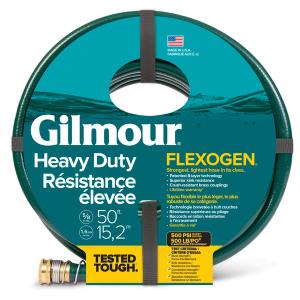Healthy grass is all about deep roots
Your grass sources everything from deep roots that tap into moist, nutrient-rich soil layers. These roots help fuel vibrant growth and color above ground, access moisture below ground during dry spells, and protect against heat.
Finding balance with your watering is essential to growing deep-rooted, healthy grass. Watering too little or too much can lead to issues, especially in stressful summer months.

Sunday Tip:
By fostering deep rooting, your lawn becomes tougher, needs less water, and responds better to fertilizers.
What happens when you overwater grass in summer?
Overwatering can flood the soil with water, which, over time, replaces the air pockets in the soil. If there's not enough air deep in the soil, the roots will remain closer to the surface where there is more oxygen and airflow.
But it's really hot out—how can I still be overwatering?
If your grass's roots are too short in summer, they are more likely to dry out in the hot summer sun, even if you water daily.
Even in the driest conditions, excessive watering can result in soil flooding and a lack of oxygen for your soil and roots. When this happens, your grass is a prime target for drought stress.
When grass is drought-stressed, roots shrink, limiting access to deeper moisture. You may see:
- Slowed top leaf growth
- Grass may become dormant or thin progressively
- Brown spots, thin patches, or bare areas
How to fix an overwatered summer lawn
So, how do we fix this? Three easy steps.
Assess your grass
Look for damage or susceptibility to damage.
- Roots primarily near the soil surface to reach more oxygen
- An elevated appearance of fungi or risk of fungal diseases
- Drought-like signs of brown spots, thinning, and patchiness, especially during periods of intense heat
You will be able to repair thinning and bare patches once conditions improve. Be patient and wait for the right season.
Audit your irrigation system
Ensure you’re not wasting water and applying the right amount in the right places. A quick irrigation or sprinkler audit can help.
- Check for leaks or broken irrigation heads and fix any issues.
- Place rain gauges or tuna fish cans throughout your lawn.
- Run your sprinkler for a specified amount of time
- Measure how much water was collected in the cans.
- Calibrate your irrigation clock so it waters between 0.3–0.5 inches per 30-minute watering session.
Change up your watering practices
Water your lawn deeply and infrequently. This is how you get water to penetrate as deeply as possible into the soil for deep-rooting grass:
- Limit watering to 1–3 times per week, depending on natural rainfall.
- Water between 1/3 to 1/2 inches per 30-minute watering session. Opt for uniform coverage as much as possible, but understand that shady areas may require less water, and sunny or more exposed areas may need more.
- Allow the soil time to dry in between irrigation sessions.
If drought is persistent—water based on your regional needs until conditions improve
Northeast, Midwest and North Central
If it hasn't rained for 1-2 weeks and browning is evident, water deeply, aiming for 1/3 to 1/2 inch every two weeks until rainfall. This won't fully revive the green, but it will help your grass survive.
Southeast
Natural rainfall usually suffices due to the prevalence of drought-tolerant warm-season grasses. However, for drought-stressed lawns, water about 1/3-1/2 inches once a week and aim for 50–75% greenness to sustain the lawn.
Western Half of the U.S.
Drought conditions hit this region most intensely. Adhere to local water restrictions as much as possible and water approximately 1/4 inch every two weeks during lawn dormancy. Be prepared to adjust watering techniques based on your lawn's response to drought.
Sunday Tip:
Avoid overwatering your lawn when possible and make adjustments when needed—for example, if it rains, simply don't water.
Recognizing lawn recovery
Drought periods might not let your lawn return to its full green glory – and that's okay. Adjust your regional watering, stay patient, and remember that lawn recovery takes time. Following Sunday’s lawn care practices and smart watering during stress, you're on the path to a stronger lawn. Here’s what you can expect:
- Longer green periods
- Better resistance to environmental shifts
- Deeper roots – unlike overwatered grass!
- Thick growth with fewer weeds
Cited sources
Avoid Overwatering Lawns & Landscapes. University of Nebraska-Lincoln
Don't let watering your lawn be too much of a good thing. UGA Cooperative Extension - Bulloch County Extension.
How often should grass be watered? Texas A&M Agrilife Extension.
Irrigation Practices for Homelawns. Purdue University Extension.
Water-saving strategies for home lawns. UMN Extension.



















